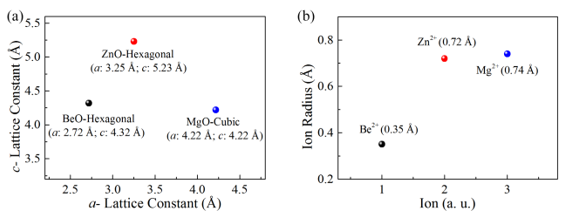- Submissions

Full Text
Research & Development in Material Science
Bandgap Modulation Based on II-VI Oxides
Longxing Su*
School of Microelectronics, Southern University of Science and Technology, China
*Corresponding author: Longxing Su, School of Microelectronics, Southern University of Science and Technology, Shenzhen, 518055, China
Submission: January 20, 2022;Published: January 26, 2022

ISSN: 2576-8840 Volume 16 Issue 4
Introduction
Zinc Oxide (ZnO), as a traditional II-VI semiconductor material with direct wide bandgap of 3.37eV and large exciton binding energy of 60meV, has been regarded as a promising candidate for optoelectronic devices including light emitting diodes (LEDs), lasing diodes (LDs), and ultraviolet (UV) photodetector [1-3]. For realizing such high-performance optoelectronic devices, bandgap engineering is extremely important. High quality multiquantum wells (MQWs) are required within a standard LED structure, in which the bandgap of the barrier layer is widened by alloying BeO (or MgO) with ZnO. For UV photodetectors, ZnO-based ternary or quaternary alloys with adjustable bandgaps are demanded to realize different cut-off response wavelengths. In this case, the tunable bandgap plays a key role as an optical filter, intercepting the incident lights with photon energy smaller than the bandgap of the material. Therefore, bandgap modulation based on II-VI Oxides (ZnO, BeO, and MgO) is urgently required, while some key issues are still beyond challenge.
Figure 1 presents the crystal structure and lattice constants of BeO, ZnO, and MgO; and the ion radius of Be2+, Zn2+, and Mg2+. MgxZn1-xO is first proposed by doping appropriate amount of Mg into the host lattice of ZnO. The ion radius of Mg2+ (0.74Å) is close to that of Zn2+ (0.72Å), thus the lattice distortion of MgxZn1-xO can be effectively suppressed. However, owing to the crystal structure difference between ZnO (Hexagonal) and MgO (Cubic), phase transition of MgxZn1-xO occurs when x≥0.33, and corresponding bandgap is limited to 3.99eV [4,5]. BexZn1-xO also encounters the problem of bandgap limitation, while it reveals quite different physical characteristics. Though both BeO and ZnO belong to hexagonal structure, the lattice mismatch between BeO (a: 2.72Å; c: 4.32Å) and ZnO (a: 3.25Å; c: 5.23Å), and the ion radius difference between Be2+ (0.35Å) and Zn2+ (0.72Å) are large. Therefore, localized lattice distortion and phase separation are observed in BexZn1-xO [6-8]. The bandgap of BexZn1-xO is only widened to 3.55eV, and the Be2+ with small ion radius also has chances to occupy the interstitial sites. Finally, we introduce a quaternary BexMgyZn1-x-yO alloy with low Be/Mg atom ratio, the bandgap of BexMgyZn1-x-yO can be widened to 5.14eV while the hexagonal structure is still maintained [9]. The success of BexMgyZ O can be ascribed to 1, Be substitution induces tensile strain compensates the compressive strain caused by Mg substitution; 2, tetra-coordination preference of Be atom should suppress the lattice distortion induced by the Mg atom with six-coordination preference .
Figure 1: (a) The crystal structure and lattice constants of II-VI Oxides (BeO, ZnO, and MgO); (b) the ion radius of Be2+, Zn2+, and Mg2+.

In conclusion, we have achieved in this effort is demonstrating the wide range bandgap modulation of quaternary BexMgyZn1-x-yO alloy with specific atomic ratio. Our work regarding to the bandgap engineering is an important step towards high performance ZnO based optoelectronic devices.
Acknowledgment
This work was financially supported by the National Natural Science Foundation of China (No. 52172149, 61705043, 51872132, 52122607).
Conflict of Interest
The author declares that he has no conflict of interest.
References
- Look DC (2001 ) Recent advances in ZnO materials and devices. Mater Sci Eng B Solid State Mater Adv Technol 80(1-3): 383.
- Chu S, Wang GP, Zhou WH, Liu JL (2011) Electrically pumped waveguide lasing from ZnO nanowires. Nat Nanotech 6(8): 506-510.
- Su LX, Zhang QL, Wu TZ, Chen MM, Su YQ, et al. (2014) High-performance zero-bias ultraviolet photodetector based on p-GaN/n-ZnO heterojunction. Appl Phys Lett 105: 072106.
- Su LX, Zhu Y, Zhang QL, Chen MM, Ji X, et al. (2013) Solar-blind wurtzite MgZnO alloy films stabilized by Be doping. J Phys D: Appl Phys 46(24):
- Su LX, Zhu Y, Zhang QL, Chen MM, Ji X, et al. (2013) Structure and optical properties of ternary alloy BeZnO and quaternary alloy BeMgZnO films growth by molecular beam epitaxy. Appl Surf Sci 274: 341-344.
- Su LX, Zhu Y, Chen MM, Zhang QL, Su YQ, et al. (2013) Temperature-dependent structural relaxation of BeZnO alloys. Appl Phys Lett 103(7): 072104.
- Su LX, Zhu Y, Xu XJ, Chen HY, Tang ZK, et al. (2018) Back-to-back symmetric Schottky type UVA photodetector based on ternary alloy BeZnO. J Mater Chem C 6: 7776.
- Su LX, Chen HY, Xu XJ, Fang XS (2017) Novel BeZnO based self-powered dual-color UV photodetector realized via a one-step fabrication method. Laser & Photonics Rev 11: 1700222.
- Su LX, Zhu Y, Yong DY, Chen MM, Ji X, et al. (2014) Wide range bandgap modulation based on ZnO-based alloys and fabrication of solar blind UV detectors with high rejection ratio. ACS Appl Mater & Inter 6: 14152.
© 2022 Longxing Su. This is an open access article distributed under the terms of the Creative Commons Attribution License , which permits unrestricted use, distribution, and build upon your work non-commercially.
 a Creative Commons Attribution 4.0 International License. Based on a work at www.crimsonpublishers.com.
Best viewed in
a Creative Commons Attribution 4.0 International License. Based on a work at www.crimsonpublishers.com.
Best viewed in 







.jpg)






























 Editorial Board Registrations
Editorial Board Registrations Submit your Article
Submit your Article Refer a Friend
Refer a Friend Advertise With Us
Advertise With Us
.jpg)






.jpg)














.bmp)
.jpg)
.png)
.jpg)










.jpg)






.png)

.png)



.png)






